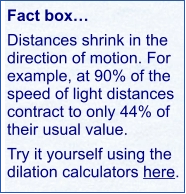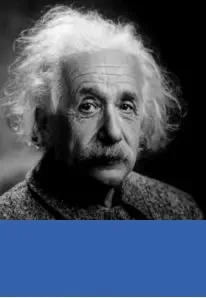
SuperFast Guide to Special Relativity




Quick and easy summaries of relativity and related subjects
Developed by Albert Einstein in 1905, Special Relativity is a fundamental theory in
physics that revolutionized our understanding of space, time, and energy. An important
aspect of the theory is that the speed of light in a vacuum is constant, regardless of the
motion of the light source or observer.
At the heart of Special Relativity are two key postulates or assumptions:
The Principle of Relativity: The laws of physics are invariant (i.e. the same) in all
inertial (i.e. stationary) frames of reference.
The Constancy of the Speed of Light: The speed of light in a vacuum is the same
for all observers, at 3 x 10
8
meters per second (186,300 miles per second).
These seemingly simple postulates have profound implications for our understanding
of space and time, although they aren’t obvious at first. One of the most famous
consequences is the mass-energy equivalence, encapsulated in the equation E=mc
2
,
which states that mass can be converted into energy and vice versa. This principle
has far-reaching implications, including the explanation of nuclear energy and the
functioning of stars such as the Sun.
Special Relativity also predicts several counterintuitive phenomena that become
increasingly apparent with increasing speed. These include:
Time Dilation: Moving clocks run slower compared to stationary ones. This
means that time effectively slows down for objects moving at high velocities.
The theory also introduces the concept of spacetime, a four-dimensional
continuum where space and time are intertwined.

Special Relativity is so-called because it is a special case of General Relativity, and
has been confirmed by a large number of experiments. Practical applications
include technologies such as the GPS (Sat Nav) system, the satellites of which
need to take into account relativistic effects in order to maintain accuracy.
In summary, Special Relativity is a cornerstone of modern physics that has
reshaped our understanding of the universe. It challenges our intuitive ideas of
space and time, providing a more accurate description of reality at high speeds. It
continues to influence scientific thought and technological innovation more than a
century after its inception.
More information and detail can be found by clicking on the in-text links or from the
menu near the top of the screen. Suggested further reading:
The Constant Speed of Light - A very strange constant
Time Dilation - How time changes for anything moving relative to another body

Advertisement

SuperFast Guide to
Special Relativity
[ Special Relativity ] [ General Relativity ] [ Einstein ] [ Time Dilation ]
[ Black Holes ] [ Twin Paradox ] [ Time Dilation Formula ]
[ Special Relativity ] [ General Relativity ] [ Einstein ] [ Time Dilation ]
[ Black Holes ] [ Twin Paradox ] [ Time Dilation Formula ]
Advertisement

Quick and easy summaries of relativity and related subjects
SuperFast Guide to Special Relativity
Developed by Albert Einstein in 1905, Special Relativity is a
fundamental theory in physics that revolutionized our
understanding of space, time, and energy. An important aspect
of the theory is that the speed of light in a vacuum is constant,
regardless of the motion of the light source or observer.
At the heart of Special Relativity are two key postulates or
assumptions:
The Principle of Relativity: The laws of physics are invariant
(i.e. the same) in all inertial (i.e. stationary) frames of
reference.
The Constancy of the Speed of Light: The speed of light in a
vacuum is the same for all observers, at 3 x 10
8
meters per
second (186,300 mph).


These seemingly simple postulates have profound implications for
our understanding of space and time, although they aren’t
obvious at first. One of the most famous consequences is the
mass-energy equivalence, encapsulated in the equation E=mc
2
,
which states that mass can be converted into energy and vice
versa. This principle has far-reaching implications, including the
explanation of nuclear energy and the functioning of stars such as
the Sun.
Special Relativity also predicts several counterintuitive
phenomena that become increasingly apparent with increasing
speed. These include:
Time Dilation: Moving clocks run slower compared to
stationary ones. This means that time effectively slows down
for objects moving at high velocities.
The theory also introduces the concept of spacetime, a four-
dimensional continuum where space and time are
intertwined.


Special Relativity is so-called because it is a special case of
General Relativity, and has been confirmed by a large number of
experiments. Practical applications include technologies such as
the GPS (Sat Nav) system, the satellites of which need to take
into account relativistic effects in order to maintain accuracy.
In summary, Special Relativity is a cornerstone of modern
physics that has reshaped our understanding of the universe. It
challenges our intuitive ideas of space and time, providing a
more accurate description of reality at high speeds. It continues
to influence scientific thought and technological innovation more
than a century after its inception.
Suggested further reading:
The Constant Speed of Light - A very strange constant
Time Dilation - How time changes for anything moving




[ Special Relativity ] [ General Relativity ] [ Einstein ]
[ Time Dilation ] [ Black Holes ] [ Twin Paradox ]

[ Special Relativity ] [ General Relativity ] [ Einstein ]
[ Time Dilation ] [ Black Holes ] [ Twin Paradox ]








